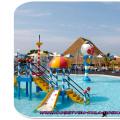Kruzenshtern's works
Literature
(at birth Adam Johann von Krusenstern, it. Adam Johann von Krusenstern; 8 (19) November 1770 - 12 (24) August 1846) - Russian navigator, admiral.
Comes from the Ostsee German nobles. Ivan Kruzenshtern and Yuri Lisyansky on the sloops "Nadezhda" and "Neva" made the first Russian round-the-world expedition.
Biography
The offspring of the Russian noble family Kruzenshterns, the great-great-grandson of the founder of the family in Russia, Philip Kruzius von Kruzenshtern, the son of Judge Johann Friedrich von Kruzenshtern (1724-1791).
For three years (from the age of twelve) he studied at a church school in Revel, and then at the Naval Cadet Corps in Kronstadt.
In May 1788, due to the war with Sweden, he was prematurely released from the corps, promoted to warrant officer and assigned to the 74-gun ship Mstislav. Immediately after that he distinguished himself in the Battle of Gogland (1788), in 1789 he participated in Eland, and in 1790 in naval battles at Revel, Krasnaya Gorka and in Vyborg Bay, after which he was promoted to lieutenant. In 1793 he was sent to study maritime art in England; sailed with the English fleet to the northern shores of America, where he participated in battles with French ships; visited Barbados, Suriname, Bermuda; went to the Bay of Bengal, in order to explore the East Indies waters and open a route to the East Indies for Russian trade. Knight of the Order of St. George, IV class Interested in the Russian fur trade with China, which went from Okhotsk by dry route to Kyakhta, Kruzenshtern came to the idea that it could more profitably go straight, by sea; he also meant to establish direct relations between the metropolis and the Russian dominions in America. In St. Petersburg, Kruzenshtern presented his views to the authorities in 1799, but his project was rejected. However, in 1802, a similar proposal was made by the main board of the RAC, Emperor Alexander I approved the project for the implementation of which it was decided to equip the first Russian round-the-world expedition. Then they remembered about Ivan Fedorovich.
The expedition, consisting of two ships ("Nadezhda" and "Neva") under the command of Kruzenshtern, with an assistant, Lieutenant-Commander Lisyansky, sailed from Kronstadt on July 26 (August 7), 1803. The expedition headed across the Atlantic Ocean and circled Cape Horn on February 20 (March 3), 1804; from the Russian and neighboring lands in the north of the Pacific Ocean, she paid special attention to Kamchatka, the Kuril Islands and Sakhalin. The expedition returned to Kronstadt on August 7 (19), 1806.
In his notes about this journey (St. Petersburg 1809 - 13), Kruzenshtern tells a lot of interesting things about what he saw on the voyage, especially about the life and customs of savages; for its time, the magnificent atlas is replete with maps, plans and drawings. Lisyansky ruled the second ship of the expedition and sometimes sailed separately from the first; in his book about the same journey (St. Petersburg 1812) there is detailed description the shores of Sitka and Kodiak.
In 1811, Kruzenshtern was appointed inspector of the classes of the naval cadet corps. In 1814, having developed detailed instructions for round the world expedition 1815-1818 under the command of Kotzebue, one of the junior officers of the first circumnavigation, Kruzenshtern visited England to order the instruments necessary for the expedition. When he returned, he received an indefinite leave and began to create "Atlas South Sea", With the attachment of hydrographic notes, under the title:" Collected works of employees with the analysis and explanation of the Atlas of the South Sea "(St. Petersburg, 1823 and 1826; French translation:" Recueil. Des memoires hydrographiques ... ", St. Petersburg, 1824-1827; addition SPb., 1835-36; this work was crowned with the full Demidov Prize).
In 1827, Kruzenshtern was appointed director of the Naval Cadet Corps and a member of the Admiralty Council. Sixteen years of activity as director was marked by the introduction of new teaching subjects into the courses of the naval corps, the enrichment of the library and museums by many teaching aids, the establishment of an officer class and other improvements.
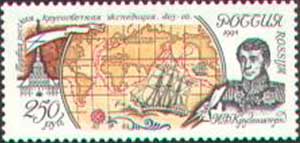
Kruzenshtern was very well developed physically. According to his contemporaries, he strongly stood out among those around him, was distinguished by an athletic physique, surpassed the strongest sailors of the expedition headed by him in the impressive shoulder girdle and heroic chest. It is known for certain that on this journey, despite the bewilderment of his colleagues, he carried two two-pound kettlebells with him and worked with them daily for 30-40 minutes, doing his favorite exercise - shvung bench press.
Kruzenshtern was a great lover of pets. On his travels he was accompanied by a spaniel, the favorite of the whole team. Before each sailing, it became a good tradition for each member of the expedition to pat the spaniel by its long drooping ears, and indeed, the voyages went surprisingly smoothly. There are literally anecdotal situations when savages, who had never seen animals with such long hanging ears in horror, fled in horror.
Kruzenshtern was buried in the Tallinn Dome Cathedral.
Memory
- In 1874, in St. Petersburg, opposite the naval building, a monument to Kruzenstern was unveiled, built according to the design of the sculptor I.N. Schroeder and architect I.A. Monighetti. The monument was erected with private funds, but a small allowance was also received from the state.
- Barque "Kruzenshtern"
- Strait of Kruzenshtern
- Kruzenshtern reef
- In 1993, the Bank of Russia issued a series of commemorative coins "The First Russian Round the World Travel".
Kruzenshtern's works
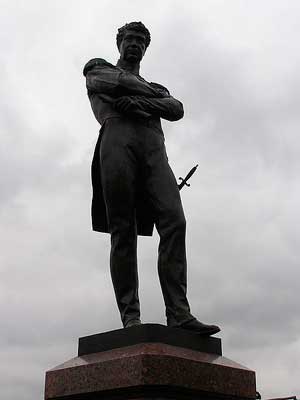
- "Wörtersammlungen aus den Sprachen einiger Völker des östlichen Asiens und der Nordwestküste von Amerika" (St. Petersburg, 1813);
- "Memoire sur une carte da detroit de la Sonde et de la rade de Batavia" (St. Petersburg, 1813);
- "Beiträge zur Hydrographie d. grösseren Oceane "(Lpts., 1819);
- articles in "Bulletin" acad. Sciences, "Notes" of the Admiralty Doctor (1807 - 27), "Nouvelles Annales de Geographie de Malte-Brun" and other publications.
- The work "Travel around the world in 1803, 1804, 1805 and 1806 on the ships" Nadezhda "and" Neva "" was published in Russian three times:
- First edition... The first part was published for the first time in 1809, the second and third - in 1810 and 1812. In 1813, a large-format Atlas was published, containing maps and illustrative material. The third part of the book was scientific, containing the results of observations, tables of longitudes and temperatures, and so on.
- Second edition was published in 1950 in modern spelling and with significant abbreviations. Highly specialized places were removed: detailed descriptions of bays and anchorages, etc., which are now placed in the sailing directions. Kruzenshtern wrote in great detail about local prices, which would require a lot of economic commentary, so these places were also released. Almost the entire third part of the work was published, leaving only the musical notation of Kamchadal and Marquis music, as well as a letter from the Minister of Commerce, Count N.P. Rumyantsev.
- Third edition(Moscow: Publishing House "Drofa", 2007) completely repeated the 1950 edition, only a new preface and illustrations from other sources were added.
Literature
Scientific biography
- V. M. Pasetskiy Ivan Fedorovich Kruzenshtern (1770-1846) / Resp. ed. Academician A.P. Okladnikov; USSR Academy of Sciences. - Moscow: Nauka, 1974 .-- 176 p. - (Scientific and biographical series). - 29,000 copies
- Lupach. V.S., I.F. Kruzenshtern and Yu.F. Lisyansky, State Publishing House geographical literature, Moscow, 1953, 46 st.
- Gennadi G. N. Reference Dictionary of Russian Writers and Scientists Who Died in the 18th and 19th Centuries. M., 1876-1908. T. 1-36.
- "Military Encyclopedic Lexicon" (vol. VII, art. A. I. Zeleny)
- "St. Petersburger Zeitung "(1839, No. 23-37, and others; Art. Academician Beer)
- Litke, "Notes" hydrograph. total (1847, book II)
- Sokolov "Notes" hydrograph. department (VIII, 1850)
- "Sea team." (1869 ,.No 6)
- A. N. Pypin, "History of Russian Ethnography" (vol. IV)
- Venyukov, "Apercu hisi des decouvertes geographiques etc."
- Ivashintsev N. A., “Review of Russian. round the world travel "(St. Petersburg, 1850)
- "Memoir of the celebrated admiral A. J. K. etc." (1856, London)
- Military encyclopedia / Ed. V.F. Novitsky, A.V. von Schwarz, V. A. Apushkin, G. K. von Schultz. - Petersburg: I.D.Sytin's T-in, 1911 .-- T. 13. - S. 318-319.
- Around the world with Krusenstern. - SPb .: Publishing house "Kriga", 2005. - P. 288. - ISBN 5-901805-16-X
- Ivan Fyodorovich Kruzenshtern is especially respected by the cat Matroskin - a literary and cartoon character from "Three from Prostokvashino" - because his grandmother "served" on the ship "Ivan Fyodorovich Kruzenshtern".
- Fyodor Tolstoy ("American") took part in the voyage of Kruzenshtern.
Ivan Kruzenshtern (1770 - 1846) - Russian navigator, admiral. He led the first Russian round-the-world expedition. For the first time, he mapped most of the coast of about. Sakhalin. One of the founders of the Russian Geographical Society. His name is borne by the strait in the northern part of the Kuril Islands, the passage between about. Tsushima and the islands of Iki and Okinoshima in the Korea Strait, islands in the Bering Strait and the Tuamotu archipelago, a mountain on Novaya Zemlya.
For the first half of the XIX v. characterized by the intensification of Russian research in various regions of the planet. Important geographical discoveries were made not only in the sphere of direct interests of Russia - in Kamchatka, Alaska, Far East, - but also in Pacific... Only from 1803 to 1826 Russia organized 23 round-the-world travels.
Ivan (Adam) Fyodorovich Kruzenshtern was the first Russian navigator to make a round-the-world voyage, who left a deep mark in history. geographical discoveries... He was born on November 8, 1770 in the Estland (Estonian) province near Revel (present-day Tallinn) in the family estate. His father, Johann Friedrich, and his mother, Christina Frederica, were not wealthy nobles. On the advice of one of his friends, when Ivan was 15 years old, his parents sent him to the Marine Corps in Kronstadt. The cadets had a rather difficult time: they lived from hand to mouth, the buildings of the corps were poorly heated, the windows were knocked out in the bedrooms, firewood had to be carried from neighboring warehouses. Many years later, Ivan Fedorovich, who dreamed of seeing his sons as sailors, nevertheless did not dare to send them to the Marine Corps, and they became students of the famous Tsarskoye Selo Lyceum.
In connection with the outbreak of the Russian-Swedish war, the graduation of cadets took place ahead of schedule. In 1788, Kruzenshtern was sent to the ship "Mstislav", but he, like the rest of the graduates, was not given the rank of midshipman who was supposed to be in such cases. In his documents there was an entry: "for the midshipman." However, he soon received the rank: the young man took part in four battles and for his displayed valor already in 1790 he became a lieutenant.
The brave, energetic and determined officer was noticed. After the end of hostilities, he was sent to continue his studies in England. Sailing on British ships, Kruzenshtern visited America, Africa, Bermuda, India and China. It was at this time that he matured the idea of the need for Russians to make round-the-world voyages for research and exploration of trade routes for Russia. Returning to Russia in 1800, promoted to lieutenant commander, Kruzenshtern submitted to the government notes: "On raising the Russian fleet by long sea voyage to the level of the best foreign fleets" and "On the development of colonial trade and the most profitable supply of Russian-American colonies with everything they need" ... Both notes remained unanswered, but after the palace coup, under Alexander I, N. S. Mordvinov became the head of the naval department, who, together with the Minister of Commerce N. P. Rumyantsev, obtained permission from the emperor for an expedition to organize sea trade with China and Japan. ... Kruzenstern was assigned to command the expedition.
The ships for the expedition, purchased in England, were named "Neva" and "Nadezhda". They also acquired the best instruments and instruments for navigation at that time. Kruzenshtern went on the "Nadezhda", and his best friend and comrade Yu. F. Lisyansky was appointed captain of the "Neva". The total number of crews was 129 people. The team consisted of Russians, only the scientists traveling with the expedition were foreigners. On board the "Nadezhda" was also the Russian ambassador N. P. Rezanov, who was sailing with his retinue to Japan.
On June 26, 1803, the ships left Kronstadt and headed for the shores of Brazil. This was the first passage of Russian ships to Southern Hemisphere... As an antiscorbutic agent on the island. Tenerife bought a large supply of the best wine, each sailor was entitled to a bottle a day. Kruzenshtern personally examined the sailors. Fortunately, thanks to the efforts of the commander, scurvy was avoided in this passage.
After a month of repairs on the Brazilian island of St. Catherine, the expedition moved to Cape Horn. Here, during the fog, the ships lost each other. Kruzenshtern went to the Marquesas Islands, and Lisyansky approached Fr. Easter and corrected Cook's mistake in defining it geographic coordinates... Travelers met at about. Nukagiva (Marquesas Islands).
Further, the expedition headed to the South Sandwich Islands, and there again split up. Kruzenshtern moved non-stop to Kamchatka, and Lisyansky went to the Sandwich Islands to replenish food and from there went to the Aleutian Islands.
From Petropavlovsk-on-Kamchatka, Kruzenshtern went to Nagasaki. During this passage, the ship was caught in a terrible typhoon and nearly lost its masts. I had to stay in Nagasaki for 6 months. The Japanese did not want to accept Rezanov; Having failed to achieve anything, the embassy was forced to return to Kamchatka. The Japanese authorities did not even allow the purchase of food. True, the emperor supplied the expedition with the necessary food for two months.
On the way back, the mariners mapped the west coast of Hondo Island (Nippon), Honshu and Hokkaido, as well as southern part Sakhalin. In the Kuril chain, they found several previously unknown islands, very low and therefore dangerous for navigation. Krusenstern called them Stone Traps. After dropping off the embassy, Kruzenshtern continued his voyage. He explored the eastern and northern coasts of Sakhalin to the mouth of the Amur, and from there went to Macau (Aomin) to meet with Lisyansky. Having taken on board a large cargo of Chinese goods, the expedition on February 9, 1806 moved to Return trip, home.
On April 15, in cloudy weather, the ships parted again. Kruzenshtern made attempts to find the Neva, but did not succeed. Lisyansky was not present at the agreed meeting place on about. St. Helena.
Later it turned out that the captain of the Neva decided to go to Kronstadt without stopping in the name of the glory of Russian seafarers. He successfully made this transition, which before him had not been possible for any of such ships. And the delayed due to the search and entry to the island. St. Helena "Nadezhda" reached Kronstadt two weeks later, on August 19, 1806. While staying in Copenhagen, the Russian ship was visited by a Danish prince who wished to meet with Russian sailors and listen to their stories.
The first Russian circumnavigation of the world was of great scientific and practical importance and attracted the attention of the whole world. Russian navigators corrected the English maps at many points, which were then considered the most accurate. Kruzenshtern and Lisyansky discovered many new islands and excluded those that did not exist, but were marked on the maps. They made observations of the temperature of the deep sea layers and currents. Gathered rich collections. For the first time in history, professional meteorological studies were carried out, which have retained their scientific significance to this day *. During the entire voyage, the currents, their directions and strength were studied, and ethnographic observations were carried out, especially valuable in relation to the Nukagives, Kamchadals and Ainu. These materials are considered classics. In addition, the expedition for the first time passed by sea from the European part of Russia to Kamchatka and Alaska, in connection with which a special medal was engraved.
These works received well-deserved recognition. The leader of the expedition received the rank of captain of the 2nd rank, was elected a member of the Academy of Sciences and the Admiralty Department.
After returning, the renowned navigator worked for a long time on theoretical issues of maritime affairs and hydrographic measurements. Kruzenshtern tried to determine the role and place of geography in the system of sciences, was interested in its connection with physics, chemistry, philosophy and history, sought to determine the influence of economics and commerce on geographical research and geographical discoveries. The opinion of the captain was considered and was in correspondence with him an indisputable authority in the field geographic research Englishman John Barrow. In particular, he asked a Russian colleague what he thought about the northwest passage.
The navigator also corresponded with Humboldt, the cartographer Espinoza and other famous scientists of that time.
The war of 1812 once again * showed the patriotism of Kruzenshtern: he donated a third of his fortune to the people's militia. During this difficult time, the scientist-navigator turned into a diplomat, was a member of the mission in London, but even here he did not cease to be interested in innovations in the field of shipbuilding, the achievements of the British fleet, examined the most important ports and docks.
The organization of Russian navigation continued to interest Kruzenshtern. In 1815, after the end of the Napoleonic wars, he took part in organizing the expedition of O. Kotzebue in search of the north-western passage.
Later, the scientist did a lot to organize other voyages, primarily for the Bellingshausen and Lazarev expedition, which ended with the discovery of Antarctica.
However, strenuous scientific studies greatly affected the health of the navigator. Due to an eye disease, he had to apply for indefinite leave to improve his health. However, this was not the main reason: the new naval minister, the Marquis Traversay, a mediocre and proud man, did not favor the favorite of the Minister of Commerce Rumyantsev and in every possible way opposed his proposals to improve the fleet and activities in the field of geographic research.
On his estate, Kruzenshtern continued his scientific studies. He finished work on a book about travel around the world, presented several notes to the Admiralty, incl. on the need to compile a "general maritime atlas". However, his ideas were ignored. Only after Traversay was replaced by Admiral A.V. Moller, who understood the significance of such a publication, the project was accepted. Alexander I agreed to issue 2,500 rubles for the publication of the navigator's book and atlas. After the publication of the atlas of Kruzenshtern, both in Russia and in Europe they began to be considered the first hydrograph of the Pacific Ocean. The atlas itself went far beyond the scope of hydrography: together with the materials of the round-the-world expedition, it greatly contributed to the further development of earth sciences.
Since 1827, the famous navigational scientist, by that time promoted to vice admiral, was the director of the Naval Corps and, thus, was able to correct the problems that tormented him in his youth. At the same time he worked in many scientific institutions. With the active participation of the admiral in Russia, the Geographical Society was organized, which became one of the most powerful and authoritative in the world.
Kruzenshtern died on August 24, 1846 in his estate Asya and was buried in Revel in the Vyshgorod (Dome) church. His work was continued by his son, Pavel Ivanovich, and his grandson, Pavel Pavlovich. Both became famous travelers who explored the northeastern coasts of Asia, the Karolinsky and other islands of the Pechersk Territory and the Ob North.
Kruzenshtern left behind a number of serious scientific works, incl. already known to the reader "Atlas of the South Sea" with an explanatory text. A round-the-world trip was described by him in the essay "Travel around the world in 1803-1806. on the ships "Nadezhda" and "Neva". The book was reprinted in an abridged version in 1950.
Http://www.seapeace.ru/seafarers/rucaptains/282.html
site is an informational, entertainment and educational site for all ages and categories of Internet users. Here, both children and adults will usefully spend their time, will be able to improve their level of education, read curious biographies of great and famous people in different eras, watch photographs and videos from the private sphere and public life of popular and eminent personalities. Biographies of talented actors, politicians, scientists, pioneers. We will present you with creativity, artists and poets, music of brilliant composers and songs of famous performers. Scriptwriters, directors, astronauts, nuclear physicists, biologists, athletes - many worthy people who have left an imprint on time, history and human development are gathered together on our pages.
On the site you will learn little-known information from the lives of celebrities; fresh news from cultural and scientific activities, family and personal life of stars; reliable facts of the biography of the outstanding inhabitants of the planet. All information is conveniently systematized. The material is presented in a simple and understandable, easy-to-read and interestingly designed form. We have tried to ensure that our visitors receive the necessary information here with pleasure and great interest.
When you want to find out details from the biographies of famous people, you often start looking for information from the many reference books and articles scattered all over the Internet. Now, for your convenience, all the facts and the most complete information from the life of interesting and public people are collected in one place.
the site will tell in detail about the biography of famous people who left their mark in human history, both in ancient times and in our modern world... Here you can learn more about the life, work, habits, environment and family of your favorite idol. About the success story of bright and extraordinary people. About great scientists and politicians. Schoolchildren and students will draw on our resource the necessary and relevant material from the biographies of great people for various reports, essays and coursework.
Learn biographies interesting people, who have earned the recognition of mankind, the occupation is often very exciting, since the stories of their destinies capture no less than other works of art. For some, such reading can serve as a strong impetus for their own accomplishments, give confidence in themselves, and help to cope with a difficult situation. There are even statements that when studying the success stories of other people, in addition to motivation for action, leadership qualities are also manifested in a person, strength of mind and perseverance in achieving goals are strengthened.
It is also interesting to read the biographies of rich people posted here, whose steadfastness on the path to success is worthy of imitation and respect. The loud names of past centuries and present days will always arouse the curiosity of historians and ordinary people. And we have set ourselves the goal of satisfying such interest in full. If you want to show off your erudition, prepare thematic material or just want to know everything about a historical person - go to the site.
Fans of reading people's biographies can learn from their life experience, learn from someone else's mistakes, compare themselves with poets, artists, scientists, draw important conclusions for themselves, improve themselves using the experience of an extraordinary personality.
Studying biographies successful people, the reader will learn how great discoveries and achievements were made that gave a chance to humanity to ascend to a new stage in its development. What obstacles and difficulties many had to overcome famous people arts or scientists, famous doctors and researchers, businessmen and rulers.
And how exciting it is to plunge into the life story of a traveler or discoverer, imagine yourself as a commander or a poor artist, learn the love story of a great ruler and meet the family of an old idol.
Biographies of interesting people on our site are conveniently structured so that visitors can easily find information about any person they need in the database. Our team strove to ensure that you like the simple, intuitively clear navigation, and the easy, interesting style of writing articles, and the original design of the pages.
Born November 19, 1770 in the Hagudis estate, Estonia into a poor noble family. He entered the naval cadet corps in Kronstadt.
The study was glorious, but during the development of hostilities with Sweden Russian state carried out mobilization, so they began to release from the buildings earlier. Ivan Kruzenshtern was also subject to this fate, and in January 1789 with the rank of "midshipman" he was sent to serve on sailing ship« Mstislav". He took part in several naval battles, including Gogland. Then he passed naval service on British ships, where he received the next military ranks.
During sea trips, while in the waters South China Sea, Ivan Kruzenshtern showed interest in trade relations between England and China. He realized that Russian side may also be interested in them. From Russia, goods could go along the sea route from Kamchatka to China and India. At that time, goods were delivered by carts through Yakutsk to the city of Okhotsk, and then by sea. This was not an entirely acceptable trade route, which was subject to many inconveniences and dangers: the likelihood of robbery on the way, damage to goods, and finally an increase in its value. All these accumulated problems have shown a desire for Ivan Fedorovich Kruzenshtern provide a draft of a new sea trade route in East Asia and India.
Ivan Kruzenshtern
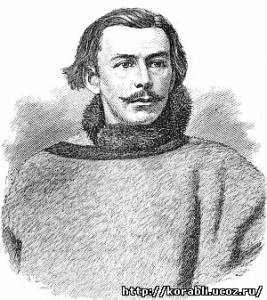
Upon returning to Russia in 1802, his plan was approved by Emperor Alexander I and Ivan Kruzenshtern led his first Russian round-the-world expedition, which consisted of two glorious " Hope"(On board which was a mission to Japan, headed by Nikolai Rezvanov) and the sloop" Neva ". The second ship was commanded by his colleague and classmate Yuri Lisyansky. The purpose expedition Kruzenshtern there was a study of the mouth of the Amur to identify convenient places for the supply of goods to the Russian Pacific Fleet... On August 7, 1802, two sailing ships left their native port of Kronstadt and headed for a given course. After some time, the sloops crossed the equator and headed further south-west. In March 1802 sailing ships« Hope" and " Neva"Having safely rounded the ever-thundering Cape Horn in a few weeks, they split up in the Pacific Ocean for a more extensive study. During the voyage, he made a description of the islands of Nuku Hiva (Marquesas Islands) and the Hawaiian Islands. In April 1805 the sloop " Hope”Reached the shores of Japan, where research was carried out on the islands of Hondo (Nipon), Iezo (Hokkaido). From there, the sailors headed to the southern shores of Sakhalin, where food and water supplies were replenished.
Ivan Kruzenshtern
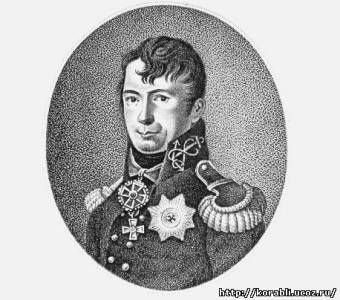
circumnavigation map of Ivan Fedorovich Kruzenshtern
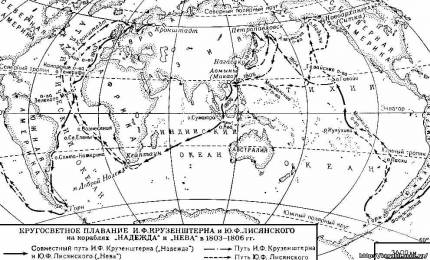
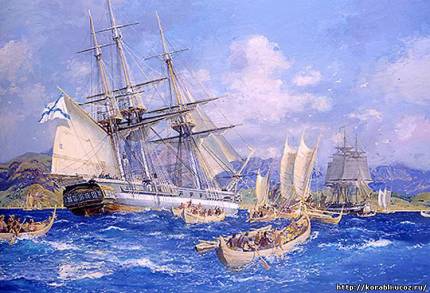
sloop "Hope"
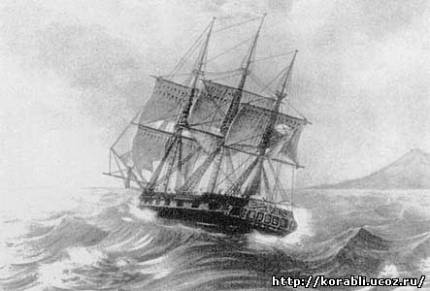
In the summer of 1805, he applied geographic map about a thousand kilometers of the coast of Sakhalin Island, and trying to pass in bad weather between the mainland and the island, he considered it a peninsula. Having rounded Sakhalin from the north, the sailors examined convenient places at the mouth of the Amur River - thus completing their an amusing trip... In 1806 sailing sloop The Nadezhda arrived in Kronstadt. Part expedition Kruzenshtern on sailing ship « Neva»Under the guidance of Yu. F., she traveled separately about this story in one of the articles, as it also deserves attention. From Kamchatka, Kruzenshtern went to China, and from there on August 19, 1806 he returned to Kronstadt, having spent more than 3 years on the journey.
sailing sloops "Nadezhda" and "Neva"
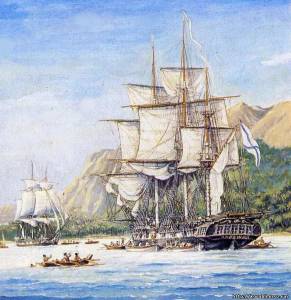
The participants of the first Russian round-the-world expedition made a great contribution to geography. Counter-trade flows were opened in Atlantic Ocean, a lot of clarifications were made about the existing islands, observations were made sea water as a result of which the concept of "specific gravity of water" was derived, a lot of data on ebbs and flows were collected, and a huge contribution was made to astronomy. His voyage yielded great scientific and practical results, in addition to geographical research, botanical, zoological and ethnographic collections were collected.
Admiral Kruzenshtern Ivan Fedorovich
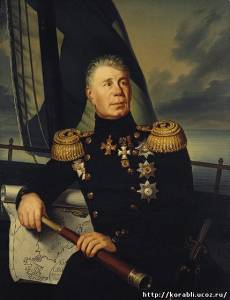
Upon his return, he was appointed a teacher at the Naval Cadet Corps. During this period of time, he wrote a book called Travel Around the World. Ivan Kruzenshtern was elected a member of the academies and scientific societies of Great Britain, France, Germany and Denmark. Navigator initiated the creation of the Naval Academy on the basis of the Naval Cadet Corps.
(1770-1846)
Admiral Ivan Fedorovich Kruzenshtern - an outstanding navigator and organizer of the first Russian circumnavigation, carried out under his command, was also a prominent scientist-hydrograph and teacher. He was born in Estland, near Tallinn (Revel), on November 19, 1770. He received his primary education at home, and from the age of twelve he studied at the Revel Cathedral school. At the age of fifteen, in 1785, I.F.Kruzenshtern was sent to the Marine Corps, then located in Kronstadt. Due to the relatively late age of entering the Marine Corps, he had to complete the general, so-called "cadet" course during a short two-year period. After that, I.F. Kruzenshtern was promoted to midshipmen and began to study mostly special naval items. While still in the corps, I.F.Kruzenshtern became close to his fellow graduate Yuri Fedorovich Lisyansky
At this time, Russia was simultaneously waging two wars at sea: with Sweden on the Baltic and with Turkey on the Black, which required the urgent appointment of a large number of officers on the ships. Together with their comrades IF Kruzenshtern and Yu. F. Lisyansky were released from the corps ahead of schedule in the spring of 1788, but without being promoted to officer, but with the designation "for a warrant officer." IF Kruzenshtern was assigned to the battleship Mstislav, commanded by the brigadier-rank captain GI Mulovsky, a brilliant, combatant, experienced sailor and a highly cultured and educated officer.
All the first years of service of the young Kruzenshtern passed in a combat situation and were marked by military exploits: in the period 1788-1790. on the Mstislav ship he took part in four battles with the Swedish fleet - Gogland, Eland, Revel and Vyborg, and all the time his ship was in the forefront. In these battles, I.F.Kruzenshtern showed great courage and management and was first promoted to warrant officer (1789), and then for the difference in the capture of a Swedish rear-admiral's ship - to lieutenant (1790). In the battle of Eland, G.I. He had a great influence on I.F.Kruzenshtern and planted in his soul the desire to achieve in the future the organization of the first Russian circumnavigation of the world. After the conclusion of peace, I.F.Kruzenshtern spent two years on the shore in Tallinn (Reval), and his relatively low employment allowed him to improve his maritime theoretical knowledge.
At that time, the Russian navy, busy with the defense of its sea borders, could not allocate warships for long training overseas voyages. Therefore, it was the practice of sending young officers as volunteers to the ships of the British Navy, which went on long voyages. Among the twelve distinguished young officers sent for 6 years (from 1793 to 1799) to England were I.F.Kruzenshtern, as well as his friend Yu. F. Lisyansky.
I.F.Kruzenshtern sailed on various English ships off the coast of North America, visited seaside towns New York, Philadelphia, Boston, Norfolk, etc., visited the West Indies and the islands of Bermuda and Barbados, and Netherlands Guiana, Africa, India and China, after which he returned to England. During these voyages, he repeatedly participated in battles with the French. Having conceived in the future to organize a round-the-world expedition and pave the way for Russian sea trade to India and China, I.F.Kruzenshteon decided to visit those waters himself and study the course of trade on the spot. On an English warship, he first reached the cape Good Hope, and then onward, to the Indian ports of Madras and Calcutta, from where he headed to Malacca and Canton. Here he was personally convinced of the possibility of carrying out trade relations between the Russian possessions in North America and China. He made the return trip to England on a merchant ship of the British East India Company, and visited the Cape of Good Hope for the second time and visited the island of St. Helena. After a six-year absence, Ivan Fedorovich Kruzenshtern returned to his homeland as an experienced and knowledgeable navigator.
Returning to Russia, I.F. Gulf of Finland... Soon he decided to take measures to realize his long-standing dream - the organization of the first Russian travel around the world, the project of which he drew up while returning by ship from China to Europe. The idea of establishing round-the-world communications with the eastern outskirts of Russia was not new. There were several developed plans for such expeditions in 1732, 1761, 1781 and 1786, but for various reasons these plans were not implemented. The closest to implementation was the round-the-world expedition organized in the composition of four warships in 1786 under the command of Captain 1st Rank G.I.Mulovsky. For this expedition, ships were already allocated, manned, and the official purpose of the expedition was to support the planned government statement on the annexation of territories discovered by the Russian people in North America to Russia, deliver goods to Okhotsk, establish trade relations with China and Japan, and open new ones along the way. lands.
The Russian government, however, was then forced to abandon sending the expedition due to the outbreak of the Russian-Swedish and Russian-Turkish wars and the complication of the general political situation in Europe.
V early XIX v. political and economic conditions were more favorable for organizing a round-the-world expedition. Already from the end of the 18th century. In tsarist Russia, capitalist relations began to develop, destroying a closed natural economy, the number of manufactories was increasing, the marketability of agriculture was growing, and trade was expanding. For the delivery of goods and the export of furs from the Russian possessions in Alaska and the Aleutian Islands, more convenient communication routes were required. Transportation of goods by land across the entire Asian mainland in almost complete off-road conditions was long and difficult. Russian voyages around the world were also a natural stage in the progress of the intensively developing Russian science. According to the project of I.F.Kruzenshtern, it was supposed, after the end of the first round-the-world voyage, to organize on Russian ships the correct sea communication between Russian European ports and Russian possessions in America. At the same time, the planned voyages were supposed to be of a scientific nature, contribute to new geographical discoveries and the study of little-known seas and oceans.
However, initially, the project of I.F.Kruzenshtern, despite the fact that it was based on careful calculations, did not meet with sympathy among the leaders of the naval ministry. But after the palace coup in 1801, the leadership of the naval department passed to the more enlightened, cultured sailor Admiral N. S. Mordvinov, who, together with the new Minister of Commerce N. P. Rumyantsev, became interested in the project of I. F. Kruzenshtern. On the initiative of Rumyantsev, the Russian-American company also took part in the implementation of the expedition. By the decision of the government, the expedition was to include two ships, and all the expenses for the maintenance of one of them were taken at the state account, and for the second - at the expense of the Russian-American company. I.F.Kruzenshtern was appointed the head of the expedition and the commander of one of the ships, and both ships were allowed to sail under military flags. I.F.Kruzenshtern's dreams gradually came true. Naturally, he thought about his friend Yu. F. Lisyansky, with whom in his youth he was accustomed to sharing these dreams. Yu. F. Lisyansky willingly agreed to this proposal.
IF Kruzenshtern and Yu. F. Lisyansky insisted on building ships for the expedition at Russian shipyards, but representatives of the Russian-American company decided to purchase them abroad. For this purpose, Yu. F. Lisyansky was sent to England in September 1802, where he bought two small ships that needed repair. These ships, which received the new names "Nadezhda" (with a displacement of 450 tons) and "Neva" (with a displacement of 370 tons), arrived in Kronstadt in early June 1803, where they began their careful preparation for the upcoming responsible voyage. IF Kruzenshtern took command of the ship "Nadezhda", and Yu. F. Lisyansky - the ship "Neva". The preparation of the expedition was carried out extremely thoughtfully, and the instructions drawn up for it and the selection of nautical tools and supplies for a long time served as a model for subsequent expeditions.
The ships had complete collections nautical charts and a well-chosen library. The expedition had many antiscorbutic agents among its supplies. The ship's provisions were of the best quality. The Academy of Sciences took an active part in the equipment of the expedition, taking upon itself the verification of some instruments, drawing up instructions (in mineralogy, botany, zoology); On May 8, 1803, the head of the expedition, I.F.Kruzenshtern, was elected a corresponding member of the Academy of Sciences. The personnel of the expedition were selected especially carefully by the commander of each of the ships, and all the sailors and non-commissioned officers went as volunteers. The crew of the ship "Nadezhda" consisted of eight officers, two doctors and 52 non-commissioned officers and sailors; in addition, there were three scientists (an astronomer and two naturalists) and three volunteers. On the ship "Nadezhda" the Russian ambassador NP Rezanov followed to Japan with his retinue, so that the total number of personnel on it reached 76 people. Among the officers was an experienced senior officer, Lieutenant M. Ratmanov and the future famous navigator F. F. Bellingshausen, and among the volunteers, O. E. Kotsebue, also later known for his scientific round-the-world expeditions. The ship "Neva" consisted of six officers, one doctor, two people from the ambassador's retinue and 44 non-commissioned officers and sailors, and only 53 people. About the selection of personnel, IF Kruzenshtern later wrote: “I was advised to accept several foreign sailors, but I, knowing the predominant properties of the Russians, whom I prefer even to English, did not agree to follow this advice. On both ships, except for Mr. Horner, Tilesius, Langsdorf and Liband, there was not a single foreigner on our journey. "
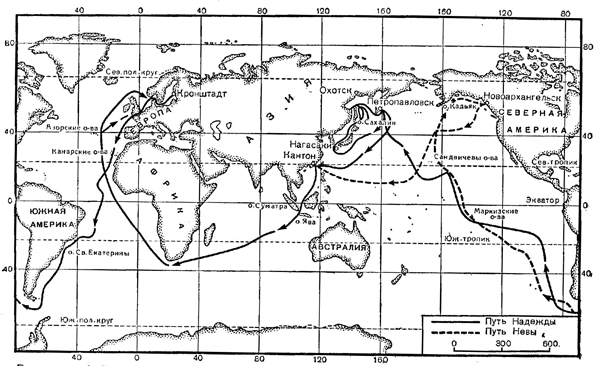 The route of the expedition was tentatively outlined in the following form: both ships sail jointly from Kronstadt around Cape Horn to the Pacific Ocean and at the Hawaiian (Sandwich) Islands are separated: "Nadezhda" is sent further to Japan with Ambassador Rezanov and, following a diplomatic assignment, for wintering NS. Kodiak; "Neva" follows from the Hawaiian Islands directly to the shores of North America and also winters at about. Kodiak; next summer, both ships carry goods to Canton, from where they return together to Russia, around the Cape of Good Hope.
The route of the expedition was tentatively outlined in the following form: both ships sail jointly from Kronstadt around Cape Horn to the Pacific Ocean and at the Hawaiian (Sandwich) Islands are separated: "Nadezhda" is sent further to Japan with Ambassador Rezanov and, following a diplomatic assignment, for wintering NS. Kodiak; "Neva" follows from the Hawaiian Islands directly to the shores of North America and also winters at about. Kodiak; next summer, both ships carry goods to Canton, from where they return together to Russia, around the Cape of Good Hope.
On June 26, 1803, the ships "Nadezhda" and "Neva" left Kronstadt and, after short-term calls to Copenhagen, Falmouth and the Canary Islands, headed to the shores of Brazil, where on the roadstead about. Saint Catherine was delayed for more than a month for the necessary repairs. This was the first time that Russian ships entered the southern hemisphere. During the campaign, the expedition personnel and scientists, specialists, continuously made various oceanographic, meteorological and zoological observations, which were subsequently published and made a valuable contribution to geographical science. During the stops of ships in tropical ports, scientists were engaged in the collection of ethnographic, zoological and botanical collections, which, upon the return of the expedition to their homeland, were transferred to various museums, which are kept to this day. On February 20, 1804, both ships circled Cape Horn together, but after the storm they parted: IF Kruzenshtern entered the Marquesas Islands, and Yu. F. Lisyansky - on the island. Easter, after which both ships reconnected at about. Nukagiva, belonging to the group of the Marquesas Islands.
Already at this first stage of navigation in the Pacific Ocean, Russian navigators performed (in addition to the systematic meteorological and oceanographic observations) a number of scientific geographical works: Kruzenshtern and Lisyansky made detailed geographic descriptions how about. Nukagiva, and the entire group of the Marquesas Islands, and Lisyansky compiled a dictionary of the local dialect; Lisyansky, in addition, being in close proximity to about. Easter, corrected the error in determining its geographic coordinates, made by Cook.
Following the previously established route, both ships then headed for the Hawaiian Islands, in view of which they split on June 7, 1804: I.F. provisions for one of the Hawaiian Islands. The "Nadezhda" arrived on July 14, 1804 at the Petropavlovsk harbor, where the cargo of the Russian-American company was handed over and the next repair was made. After a six-week stay, on August 27, IF Kruzenshtern left Petropavlovsk for Nagasaki to deliver the Russian ambassador to Japan. The ship "Nadezhda" sailed along the eastern shores of the islands of Hokkaido and Honshu and rounded from the south about. Kyushu. On the way, I.F.Kruzenshtern, together with officers and scientists, was checking existing maps and described South coast O. Kyushu. At the last stage of the crossing, the "Nadezhda" withstood a typhoon of exceptional strength and almost lost its masts. During this passage, I.F.Kruzenshtern corrected the position of the Van Diemen Strait, which was incorrectly plotted on English and French maps.
For six months, from October 8 to April 17, 1805, the ship "Nadezhda" stood in Nagasaki, awaiting the end of diplomatic negotiations, which ultimately ended in failure: the Japanese government refused to accept the embassy. Now IF Kruzenshtern had to transport Rezanov to Petropavlovsk and then follow to Canton to connect with Yu. F. Lisyansky for a subsequent return to his homeland. For this period of his voyage, Kruzenshtern outlined for himself a whole program of geographical research and decided: 1) first of all to study the Sea of Japan, at that time almost unfamiliar to navigators, and describe its coasts, 2) describe the southern and eastern coasts of Sakhalin, 3) find out if there is a the strait between this island and the mainland, and 4) pass any new strait between the Kuril Islands located north of the Bussol Strait. He carried out almost the entire program, partly on the transition to Petropavlovsk, and partly a little later.
I.F.Kruzenshtern entered the Sea of Japan by the eastern passage of the Tsushima Strait, which was later named after him. Then he examined individual areas west coast O. Honshu and the entire western and northwestern parts of the coast of. Hokkaido with access to them. He gave Russian names to a number of coastal points and bays. Further I.F.Kruzenshtern left Sea of Japan Strait of La Perouse and described in detail and studied (with access to the shore) the shores of the Aniva Bay and part east coast Sakhalin, and made an important geographical discovery at that time, establishing the identity of the names "Sakhalin" and "Karafuto".
Along east coast were described and put on the map of the Terpeniya Bay coast (also with a visit to the coast). On leaving the Gulf of Terpeniya, the "Nadezhda" encountered ice, which is why IF Kruzenshtern decided to immediately follow to Petropavlovsk and return to Cape Terpeniya at a more favorable time. On the southern and eastern shores of Sakhalin, a number of geographic objects, capes, bays, rivers and mountains were given Russian names.
After that I.F.Kruzenshtern went to Kuril Islands to describe them, but fog, poor visibility and stormy weather prevented him. Nevertheless, to the north of the strait, now bearing his name, IF Kruzenshtern discovered a group of dangerous low islands, which he called "Stone traps". From the Sea of Okhotsk to the Pacific Ocean "Nadezhda" passed through the strait between the islands of Onekotan and Harimkhotan, now bearing the name of Krenitsyn. Finally, on June 5, 1805, the "Nadezhda" arrived in Petropavlovsk.
After the departure of Rezanov with his retinue, with which the naturalist Langsdorf departed, the unloading of Japanese cargo and the necessary pemont, on June 5, Nadezhda again put out to sea and headed directly to Cape Terpeniya, entering the Sea of Okhotsk by the strait named after Kruzenshtern's ship - the Nadezhda Strait ". Arriving at Cape Terpeniya and determining its exact location, I.F.Kruzenshtern went north along the eastern coast of Sakhalin, describing it (in places with sending officers ashore), mapping, determining the location of capes, many of which were named by him in Honor their officers (Capes Ratmanov, Bellingshausen). Having reached the northernmost tip of Sakhalin and calling it Cape Elizabeth, Kruzenshtern rounded this cape from the north, as well as Cape Maria, neighboring to the west, and headed for the Sakhalin Bay. Here he came only to the northern entrance to the Amur estuary, where his ship drifted, and one of the officers on a rowboat was sent to the south to determine the depth and width of the "channel" leading to the mouth of the Amur. A major mistake of I.F.Kruzenshtern was a superficial study of the very important question of whether Sakhalin is an island or a peninsula. Based on the rather vague data reported by his officer, about a strong current from the south, about the presence of shallow depths and, finally, about the fresh nature of the water, he concluded that there was no through passage between the island and the mainland. It is possible that Krusenstern's conclusions were influenced by the opinion of such authorities as La Perouse and Brauton. This mistake could become fatal and stop further searches for an outlet to the Pacific Ocean, if not for the courage and persistence of another Russian navigator G.I. with the Tatar Strait, who found a deep-water entrance to the mouth of the Amur and established that Sakhalin is an island.
The north-western coast of Sakhalin was thoroughly surveyed with a landfall. Not daring to "dare", as I.F. to Petropavlovsk across the Sea of Okhotsk. Despite the failure of I.F.Kruzenshtern to examine the entrance to the Amur, his biographer, the famous Russian naval historian F.F. of the most honorable places in the history of hydrography. “All this was done, with the exception of the month spent in the port of Peter and Paul, only 87 days, and this in places visited for the first time, in the seas, where the whole summer is dominated by fog. Suffice it to say that in these 87 days of astronomical definitions of points, more than 100 points are collected, and the coastline is not less than 1,500 miles explored and surveyed for the most part ”. In the Sea of Okhotsk, "Nadezhda" passed nearby about. Jonah and refined it geographical position... From the Sea of Okhotsk, the "Nadezhda" sailed with the Fourth Kuril Strait and on August 30 anchored in the Petropavlovsk port. In early October 1805, IF Kruzenshtern left Petropavlovsk and on the way to China intended to clarify the location of a number of islands, plotted on foreign maps, the existence of which seemed to him doubtful. Unsuccessfully searching for these islands, which turned out to be non-existent, IF Kruzenshtern circled from the east to Japan, the Ryukyu Islands and Taiwan and on November 20 came to the port of Macau.
On December 1, 1805, the Neva arrived there, led by Yu. F. Lisyansky. In Canton (or rather, in the Wampu roadstead), the expedition's ships received a large amount of Chinese goods, and on February 9, 1806, they set out together on their way back to their homeland. V Indian Ocean during the fog, both ships parted and proceeded on their own. IF Kruzenshtern, after a 79-day march went to about. St. Helena, where he received news of the war between Russia and France. Fearing a meeting with the enemy, he went to his homeland in a roundabout way around the Shetland Islands and, having made an 86-day march, came to Copenhagen, where he stood for four days. On August 19, 1805, he anchored in the Kronstadt roadstead. Thus ended the first Russian voyage around the world, which lasted three years and twelve days.
The three-year circumnavigation of the world by I.F.Kruzenshtern and Yu.F. Lisyansky made up an entire era in the history of Russian geographical science, Russian Navy.
The scientific results of the expedition, in addition to the already mentioned geographical discoveries and the mapping of the surveyed coasts and ports on the maps, are also in a new method oceanographic research... IF Kruzenshtern on "Nadezhda" observed deep temperatures, using the recently invented Six's thermometer for the highest and lowest temperatures. He and his companion, the astronomer Horner, made vertical series of temperature observations in seven places, and in total, deep-sea observations were carried out in nine places. The famous Soviet oceanographer and geographer Yu. M. Shokalsky believed that in time these were generally the first observations of vertical temperature series at depths in the ocean. I.F.Kruzenshtern paid great attention to the study of tidal phenomena and was personally engaged in observations of the ebb and flow during a long stay of his ship in Nagasaki. During the entire time of their voyage, Russian sailors and scientists determined the direction and speed of currents, the magnitude of the compass declination, and made meteorological observations. I.F.Kruzenshtern personally owns a summary of all observations of the elements of currents, which were deduced from a comparison of the numbered places of the ship with those determined by astronomical observations. Astronomer Horner summarized hydrological and meteorological observations and studied the specific gravity of water in various regions. It is interesting to note that the expedition established for the first time that “ sea water does not shine from the movement and friction of particles thereof, but that the real fault of that is the essence of organic matter. "
It can rightfully be argued that the first Russian circumnavigation of the world marked the beginning and created the basis for a new branch of geographical science - oceanography.
It should be noted that Russian seafarers determined their coordinates with an accuracy twice that of their immediate predecessors - foreign seafarers (for example, Vancouver). The voyage of I.F.Kruzenshtern and Yu.F. Lisyansky was not only the first Russian round-the-world voyage, but also the first Russian voyage in general, in which longitudes were determined no less often than latitudes and with a sufficiently high accuracy, even according to our modern concepts. The latitude on the "Nadezhda" and "Neva" was determined by the midday heights of the Sun whenever the weather conditions allowed, on average 20-23 times a month while sailing at sea, and longitude was determined by the heights of the Sun measured at the first vertical and by chronometers. 19-20 times. Thus, the longitudes were determined on the basis of the joint use of data on the heights of the Sun, taking into account the strokes of the chronometers and measuring the lunar distances (from them, corrections of the chronometers were derived 2-3 times a month).
Consequently, the great scientific results of the expedition are explained not only by the skill and courage of the Russian sailors, but also by their skillful use of the most advanced methods and techniques of navigation and the latest precision instruments.
The expedition members compiled detailed geographical and statistical descriptions of Kamchatka, the Marquesas Islands, coastal regions of southeastern China and Russian possessions in North America, short dictionaries in several languages, collected materials on religious beliefs, customs and other traits of various nationalities.
Thanks to the excellent organization of the expedition, good supplies and care for the personnel on the part of the command, for all three years on both ships there was not only a single death, but not even a single serious illness; there were also no material losses.
The expedition was met at home with great triumph. I.F.Kruzenshtern was elected a member of the Academy of Sciences and a member of the Admiralty Department and promoted to captain of the 2nd rank.
From 1807 to 1809 he was at the St. Petersburg port on the shore and was engaged in the processing of the materials of his expedition. The three-volume work of IF Kruzenshtern "Travel around the world in 1803, 1804, 1805 and 1806" with the addition of an excellent engraved atlas of maps and drawings was published in 1809-1812. and has been translated into most European languages. Its first two volumes contain a detailed description of the voyage, and the third volume contains scientific articles by I.F.Kruzenshtern and scientists of the expedition on oceanography, meteorology, ethnography, etc.
In 1809, IF Kruzenshtern was promoted to captain of the 1st rank and appointed commander of the battleship "Grace". This was his last combat assignment and sailing on a battleship (later he repeatedly in summer time commanded the training squadron of the Marine Corps). In 1811 he was appointed inspector of the classes of the Marine Corps, but he did this position for a very short time and was dismissed for long-term leave due to eye disease. This vacation, which he spent on his estate near the town of Rakvere (formerly Wesenberg) in Estonia, was entirely devoted to scientific pursuits, the fruit of which was the publication of the major edition of the Atlas of the South Sea with two volumes of hydrographic explanations attached. From his vacation, he was summoned several times to carry out various assignments. So, in 1814 he was organizing a round-the-world expedition of O. E. Kotsebue on the brig "Rurik", for which, being in England, he ordered astronomical and nautical instruments, and in 1918 he made a special note on the organization of the first Russian Antarctic expedition ... In 1818 he was appointed to be present in the procurement of ship timber. In 1819, I.F.Kruzenshtern was promoted to captain-commander.
The remarkable work of IF Kruzenshtern "Atlas of the South Sea" with two volumes of explanations in Russian and French was published in 1824-1826. In this work, he used the results of all Russian and foreign voyages and his personal experience and compiled the most detailed and authoritative maps of the Pacific Ocean, which have earned recognition throughout the world. Work on the maps of the Pacific Ocean did not end with the publication of the Atlas: until the end of his life, IF Kruzenshtern continued to follow all new voyages in the Pacific Ocean and made corrections to his maps (in 1835 he published additions to his Explanations "). There was not a single head of a Russian or foreign expedition who did not consider it his moral duty to inform the author of the Atlas of certain remarks and additions to his maps. Atlas of the South Sea was awarded the full Demidov Prize of the Academy of Sciences.
In 1826, the long vacation of I.F.Kruzenshtern ended. After being promoted to rear admiral, he was appointed class inspector and assistant director of the Marine Corps, and already in the next. 1827 - director of this building and a member of the Admiralty Board. From that time on, his fifteen-year pedagogical and educational work began as director of the Marine Corps. In it, he showed his progressive ideas in educating the young generation of sailors, significantly improved the pedagogical process, organized laboratories and classrooms, an astronomical observatory and a museum, selected qualified teachers, paid great attention to teaching foreign languages. He was an ardent champion of the need for higher professional education for sailors and organized the so-called Officers' classes with a three-year course of study at the Naval Corps, which were later renamed the Naval Academy. At the invitation of the director, such outstanding scientists as academicians M. V. Ostrogradsky, V. Ya. Bunyakovsky, E. Kh. Lenz and A. Ya. Kupfer gave lectures in these classes. The progressive reforms of I.F.Kruzenshtern met with opposition among the reactionary officers, and one of the reasons for his resignation must be considered the contradiction of these reforms to the spirit and mores of the Nikolaev regime. In 1829, Kruzenshtern was promoted to vice admiral, in 1841 - to admiral, and in the same year he was expelled from the post of director of the Naval Corps, but until his death he was on active naval service.
IF Kruzenshtern throughout his life, after returning from a circumnavigation of the world, was intensively engaged in scientific activities and maintained scientific contacts with the most prominent Russian and foreign scientists. He was an excellent linguist and corresponded with Humboldt, Murchison, the famous Spanish cartographer Espinoza and other major scientific authorities in the field of cartography and hydrography. His scientific merits were highly appreciated: he was an honorary member of the Academy of Sciences, an honorary doctor of philosophy at the University of Dorpat and a corresponding member of many foreign scientific societies and institutions. IF Kruzenshtern was one of the founding members of the Russian Geographical Society.
The jubilee of I.F.Kruzenshtern, celebrated with great solemnity at the beginning of 1839, turned into his true triumph, but the hero of the day was especially valuable the presence at the festival of two old sailors, former participants in his circumnavigation of the world, who arrived in St. Petersburg from the most remote outskirts of Russia ...
I.F.Kruzenshtern died on August 24, 1846 at his estate Ass, near Rakvere (Vesenberg), and was buried in Tallinn (Revel) in the Vyshgorod church. On the embankment Vasilievsky Island opposite the Marine Corps in St. Petersburg, a monument was erected to him with funds collected from his students and teachers.
The name of Ivan Fedorovich Kruzenshtern went down in the history of Russian science as the name of a brave navigator, organizer of the first Russian round-the-world expedition, as an ardent patriot, as a prominent hydrographic scientist and as a charming, humane, progressive figure.
Bibliography
- Shvede EE Ivan Fedorovich Kruzenshtern / EE Shvede // People of Russian Science. Essays on outstanding figures in natural science and technology. Geology and Geography. - Moscow: State publishing house of physical and mathematical literature, 1962. - S. 382-393.




